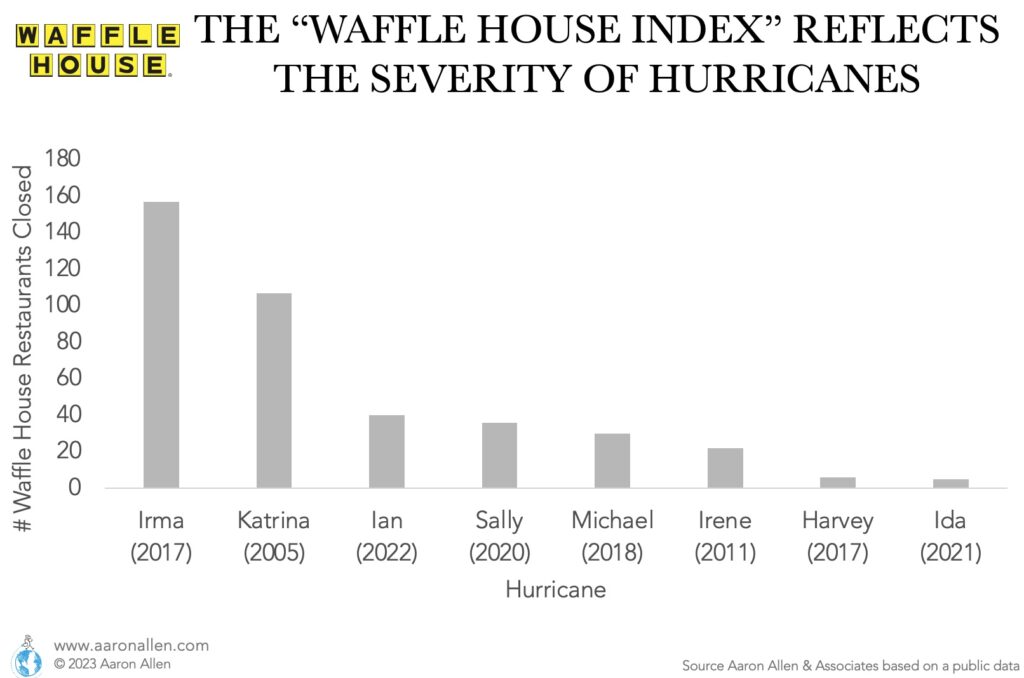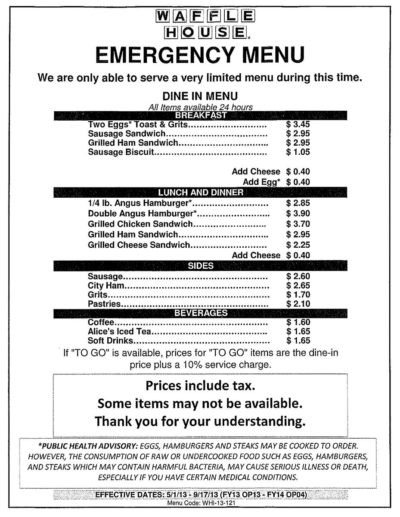It seems like “once in a lifetime” natural disasters are happening more and more often these days. From global pandemics to earthquakes and hurricanes, Mother Nature is hitting hard. While the impact on individuals and communities alike is substantial across the board, businesses are also learning to weather the storm from these “acts of God” — both mom-and-pops and chained operators alike.
There’s no real “restaurant disaster recovery plan” playbook because, put simply, no two disasters are the same. But restaurants have recovered — and helped others recover — in a myriad of ways.
THE WAFFLE HOUSE INDEX
The destruction following the massive May 2011 tornado in Joplin, Missouri, was unthinkable. Homes were demolished. Shingles had been ripped off the tops of schools. Dozens were missing. But amongst the wreckage, the yellow florescent signs of two area businesses stood out like shining beacons of light: Joplin’s two Waffle House restaurants were open. The chain of 24-hour diners have since become unlikely tools of the Federal Emergency Management Agency (FEMA), used to measure of the severity of a storm. Craig Fugate, former FEMA Administrator, has even said, “If you get [to a disaster-ravaged area] and the Waffle House is closed? That’s really bad.”
Because Waffle House notoriously stays open through nearly every type of weather, the restaurant’s operations (or lack thereof) in the wake of a storm have become a measure of its intensity. It’s known as FEMA’s “Waffle House Index” and it looks something like this:

With thousands of restaurants in states vulnerable to hurricanes and tropical storms, the Waffle House Index has become an indicator of the situation and potential damage. In 2022, as Hurricane Ian moved through Florida, 40 Waffle House locations closed — a large number but minor compared to Katrina in 2005 (107 Waffle House restaurants were closed) and Irma in 2017 (more than 150 Waffle House restaurants were closed). In 2023, Hurricane Idalia is threatening Tampa and parts of the Florida Gulf Coast.

As a privately-owned company, Waffle House has comparatively fewer resources at its disposal than many other organizations that aid in disaster relief, making its reputation for disaster response even more noteworthy.
RESTAURANTS GIVE TO THE COMMUNITY IN THE WAKE OF DISASTER
Often, restaurant disaster recovery is less about the restaurant itself, and more about the community at large. In August 2017, in the wake of Hurricane Harvey, Texas-based fast food chain Whataburger pledged $1 million to its Whataburger Family Foundation, $150,000 of which would go toward the Red Cross, and $500,00 to local food banks. Additionally, the burger chain donated food to first responders in the Houston area, making headlines after posting a video of a first responder taking his first bite of Whataburger and exclaiming, in a thick New York accent, “That is a good burger.”

While serving first responders we ran into a NYer who got his first sweet taste of Whataburger pic.twitter.com/AzYbryw8cn
— Whataburger® (@Whataburger) September 2, 2017
Yum China Holdings (which operates brands including KFC, Pizza Hut, and Taco Bell) committed more than half-a-million dollars to support relief efforts following a 7.0-magnitude earthquake that struck Jiuzhaigou County in Sichuan Province in August 2017. The donation was made through the China Foundation for Poverty Alleviation and aims to contribute to the post-disaster reconstruction and recovery program.
Anheuser-Busch has made a name for itself in terms of disaster recovery efforts, too, often pausing beer-bottling operations to instead produce thousands of cans of water to be delivered to disaster zones. The company periodically halts brewery production throughout the year at its Cartersville, Georgia brewery so it can be prepared to “help American communities in times of need.” It sent more than 155,000 cans of safe drinking water to aid those hit by Hurricane Harvey in Texas and Louisiana.
RESTAURANTS AIM TO MAKE A DIFFERENCE
Chick-fil-A has been known to donate food in times of disaster recovery but a Texas Chick-fil-A manager took things even a step further when he not only delivered food to a couple stranded on their second floor — but delivered a mode of transportation, as well. Though JC Spencer and his wife Karen weren’t able to contact first responders for rescue, they were able to get in touch with Chick-fil-A, ordering two grilled chicken burritos (with extra egg), and a boat on the side.
The restaurant manager — the only person able to reach the store at the time, due to flooding — passed on the call to a co-worker, whose husband set out for Spencer’s house with a fishing boat and two jet skis in tow. What followed was one of the most remarkable photos published after Hurricane Harvey ravaged Texas (shown left): Karen on the back of a Jet-ski, in the middle of her living room.

Following the devastating 2010 earthquake in Haiti, Celebrity Chef José Andrés founded World Central Kitchen in the hopes that food could serve as an agent of change. Since its inception, the group has implemented culinary training to increase income and create jobs in affected communities in Brazil, Cambodia, Cuba, Dominican Republic, Haiti, Nicaragua, Zambia, and the United States. Additionally, the organization supports feeding programs that encourage school attendance and provide a source of sustainable revenue for the school.
In August 2017, Cortez, Florida restaurant The Swordfish Grill became a makeshift staging area for donated water, food, clothing, diapers, and supplies during Hurricane Harvey relief efforts. The restaurant took to Facebook to post videos and photos of donations (which were then delivered by boat to affected areas), and update followers on the success of the drive.
THE IMPORTANCE OF A RESTAURANT DISASTER RECOVERY PLAN
Just as a disaster is unavoidable, so is having a plan. Without one, operators are playing a risky game, courting disaster with no operating procedures in place. A disaster recovery plan that is properly tested and easily executed is critical for businesses to have in place, no matter the circumstances. At Waffle House, for instance, a number of people and resources are dedicated to hurricane planning, with a leadership team comprised of senior management from each of the company’s functional areas participating in annual preparation meetings as well as on-the-ground response. According to the chain’s director of purchasing, response processes are well-documented, with a checklist on hand at all locations: “[Response teams] won’t be lost if they lose the checklist.”

Even the loss of a single system can send a chain into chaos. Demonstrating confidence — to both staff and to guests — is important, but equally important is the speed at which a restaurant responds to a disaster — both at the unit- and corporate-level. Speed hinges on a plan, of course, so having the tools in place to execute that are tantamount to its success.
RELATED CONTENT
22 Biggest Crisis Communications Challenges in Restaurant History
The Importance of Protecting A Restaurant’s Intellectual Property
What to Do When Sales Are Down
* * *
ABOUT AARON ALLEN & ASSOCIATES:
Aaron Allen & Associates is a leading global restaurant industry consultancy specializing in growth strategy, marketing, branding, and commercial due diligence for emerging restaurant chains and prestigious private equity firms. We work alongside senior executives of some of the world’s most successful foodservice and hospitality companies to visualize, plan and implement innovative ideas for leapfrogging the competition. Collectively, our clients post more than $300 billion, span all 6 inhabited continents and 100+ countries, with locations totaling tens of thousands.

